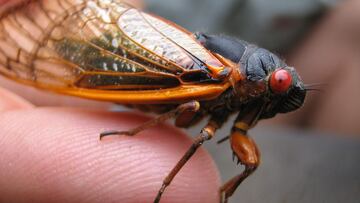What are cicadas, what do they feed on and why do they come out in May?
Cicadas are split into two main groups, annuals and periodicals. The latter can spend up to 17 years hiding under ground before emerging in the trillions.

Americans from Wisconsin down to Arkansas and over to the East Coast between Delaware and Georgia are bracing for a month or more of incessant loud buzzing. Two cicada broods will be emerging this year, overlapping in some areas, with trillions of the critters taking to the treetops to seek out a mate.
These intriguing insects have fascinated scientists and mankind because of their amazing lifecycles since ancient times. They can disappear for years on end, only to emerge en masse.
What are cicadas?
There are over 3,000 species of cicadas, which are “classified in the order Hemiptera, along with aphids, leafhoppers, and shield bugs” according to the National Wildlife Federation. The various cicada species are split into two main groups, annuals and periodicals, but they all have a three-stage lifecycle, egg, nymph, and adult.
The annual cicadas are dark with greenish markings. They generally live for two to five years but spend most of that time buried underground. Annual cicadas can emerge from their burrows throughout the summer.
While annual cicadas can be found all over the world, periodical cicadas are only native to the eastern half of North America. These cicadas have black backs, orange undersides, red eyes and are just over an inch in length. Their wings are clear and membranous with black veins with a span of roughly three inches.
There are 15 periodic broods which have 13-year or 17-year life cycles. Each one of them is specific to a certain geographical region. Scientists still don’t understand exactly why or how these broods know the right moment to come out all at once.
Why do cicadas come out in May?
It’s believed that coming out en masse provides protection from predators in that through sheer numbers, enough of them will survive in order to mate. As for when they come out, the soil temperature has to be above 64 degrees.
Generally, they start to appear in April in more southern areas but may not emerge until as late as June. In Illinois where both the brood XIX and brood XIII will converge, they are expected to make their presence fully felt in May says CBS News.
What do cicadas feed on?
While cicadas are herbivores, they are not destructive like locusts when they emerge in the billions and trillions. As nymphs, they feed off the plant roots sucking liquids from them. As adults, they feed on sap from tree roots, young twigs and branches.
During neither stage do they cause significant damage to plants and are not considered an agricultural pest. However, especially large broods can overwhelm young trees from adults feeding on them and the females making holes in branches to lay their eggs.
While their mouths are like that of a mosquito, they do not typically use them on anything other than plants to get at the sap inside them. For example, they will not “consume the plants in your vegetable or flower gardens” according to Orkin. The pest control company also says that cicadas aren’t known to transmit any known diseases to people or animals.






